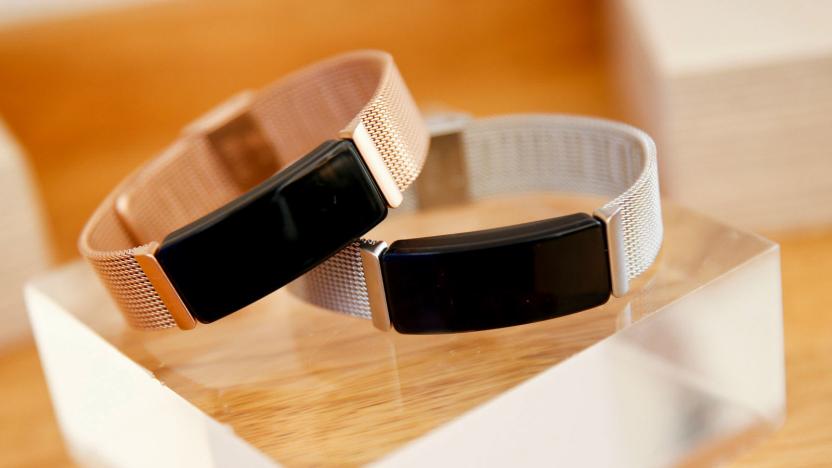sniffer
Latest

A Bluetooth vulnerability could give hackers your location
Your Fitbit and other Bluetooth gadgets could be giving away your location data. Researchers from Boston University (BU) detected a vulnerability in several high-profile Bluetooth devices that could allow third-parties to determine your location and other sensitive information. In the wrong hands, that information could be used for stalking or abuse. That's especially concerning given that basically everyone is carrying around a Bluetooth device.

UK police are using detection dogs that can sniff out USB drives
Devon & Cornwall and Dorset Police have begun utilising special FBI-trained sniffer dogs that have been specifically trained to detect hidden storage devices. Police dogs Tweed, a 19-month-old springer spaniel, and Rob, a 20-month-old black Labrador, are the first dogs outside of the US that will help track "terrorists, paedophiles and fraudsters" by tracing the unique chemicals found in hard drives, USB sticks and SD cards.

Hitachi boarding gate can sniff explosives on passes, keep the transport queues flowing (video)
Anyone who's hopped on a flight at a major airport, or even some land-based transit, knows the agonizing wait that certain agencies demand while they scan for explosives and check boarding passes. Hitachi is working with Nippon Signal and the University of Yamanachi to build a new boarding gate that hopefully kills those two security birds with one stone. As you're swiping your boarding pass (or smartphone), the machine also scans it for particle-sized traces of explosive materials and sends the all-clear or no-go in less than two seconds. If all goes well, the system could check up to 1,200 passengers every hour at a single gate -- a rate quick enough to prevent a logjam at even the busiest terminals. Our chief reservations surround its scope. Hitachi has earned enough trust to get trial installations at Narita International Airport and a Tokyo subway station this coming spring, but we have a hunch that some airport officials would demand a more thorough screening, no matter how much it's actually needed.

Wolfhound sniffs out inmates' cellphones much better than an actual wolfhound would (video)
Are you the warden of a small-town prison, or perhaps an irate movie theater usher who's sick of ungrateful patrons interrupting Step Up 3D because they can't be bothered to turn of their handsets? Cellphone jamming is, for the most part, still out of the question, so Berkeley Varitronics has introduced a little something called the Wolfhound. Previously known as the Bloodhound, the device lets you hone in on RF signals, which means it won't help you if phones are powered down, but if your perp has one on standby, or if they're talking, texting, or surfing the web, you're golden. Interested? Of course you are! Hit the company up for a price quote -- but not before checking the video after the break.

Hacker intercepts phone calls with homebuilt $1,500 IMSI catcher, claims GSM is beyond repair
In 2009, Chris Paget showed the world the vulnerabilities of RFID by downloading the contents of US passports from the safety of his automobile. This year, he's doing the same for mobile phones. Demonstrating at DefCon 2010, the white hat hacker fooled 17 nearby GSM phones into believing his $1,500 kit (including a laptop and two RF antennas) was a legitimate cell phone base station, and proceeded to intercept and record audience calls. "As far as your cell phones are concerned, I'm now indistinguishable from AT&T," he told the crowd. The purpose of the demonstration was highlight a major flaw in the 2G GSM system, which directs phones to connect to the tower with the strongest signal regardless of origin -- in this case, Paget's phony tower. The hacker did caveat that his system could only intercept outbound calls, and that caller ID could tip off the owner of a handset to what's what, but he says professional IMSI catchers used by law enforcement don't suffer from such flaws and amateur parity would only be a matter of time. "GSM is broken," Paget said, "The primary solution is to turn it off altogether." That's a tall order for a world still very dependent on the technology for mobile connectivity, but we suppose AT&T and T-Mobile could show the way. Then again, we imagine much of that same world is still using WEP and WPA1 to "secure" their WiFi.

KisMAC dev calls it quits
Reader Andrew dropped a note that Michael Rossberg, developer of KisMAC, the wireless network sniffer based on Kismet, has declared the project discontinued. I can't get the project's website to load (most likely because it's been Slashdotted), but apparently the reason Rossberg gave was that a change in Germany's laws would make it dangerous for him to continue working on it. The law apparently makes it illegal for anyone to sniff out a password that "allows access to data", and since that's a big part of KisMAC's function, Rossberg is calling it quits.But he is asking for interested parties to continue his work, in the EU or the US, so if the site ever returns, feel free to grab the source and check it out yourself. Of course, from what Slashdot commenters are saying, this isn't much of a loss anyway-- the program hasn't seen any real updates in a long time, and apparently it didn't even work with the new MacBooks. In terms of network finders, there's lots more to choose from (including iStumbler, which I didn't mention in the other article), but in terms of cracking WEP and WPA keys (legally, of course), are there any other OS X specific options out there?Update: Clarification: the program will run on MacBooks, but it doesn't do anything but find networks, which is just a fraction of the intended functionality.

Creation adds sixth sense for WiFi hotspots
We know, there are (supposedly) folks out there with the ingrained ability to sense wireless networks without any mechanical assistance whatsoever, but considering that we can't all live next door to Kate Figes, the rest of us mere mortals need a bit of manmade aid. Enter the WiFi Heartbeat, a custom built sensor / vibration device that autonomously sniffs out WiFi signals, determines the signal strength, and sends a pulsing signal to you based on just how close the hotspot is. The creator states that all you'll need is a "microcontroller, some custom interface electronics, a small vibe motor, and an off-the-shelf WiFi detector," and if you've given mildly difficult DIY endeavors a go before, we can't imagine this one causing too much strife. For those of you still on the fence, be sure to hit the read link for all the details you'd need to craft your own, and click on through for the video demonstration.[Via MAKE]

Stealthy Insect Sensor Project unleashes bees to sniff out bombs
While homemade nuke detectors patrolling our waterways seems sufficiently plausible, remote-controlled rats searching for explosives is certainly pushing the bounds of acceptability, but to expect a swarm of "highly trained" bees to sniff out destructive material (without getting medieval on somebody) sounds like an awful lot of buzz. Nevertheless, an 18-month research study -- dubbed the Stealthy Insect Sensor Project -- at the US Energy Department's Los Alamos facility has just concluded, and team members have announced resounding success in teaching your average bee to "stick their proboscis (that tube they use to feed on nectar) out in the presence of explosives." The DHS sees potential in using the little buggers to "find dynamite and C-4 plastic explosives" as well as relatively dodgy "Howitzer propellant grains." Scientists have used a reward system to train the animals, by offering up a "sugar treat" each time they correctly signify explosive material, and suggest that teams of detectors (read: incensed bees) could be carried about in "portable containers about the size of a shoebox." While theoretically, this plan may seem sound, what happens when our enemies start covering their tracks in nectar -- or worse, when the insects unleash a painful revolt against our own brethren?



